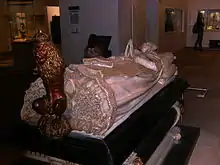Cornelius Cure
Cornelius Cure (died 1607) was an English-born sculptor of Dutch parentage, being the son of the sculptor, William Cure I.

Cure lived and worked in Southwark in Surrey (now London). William Cecil, Lord Burghley recommended his appointment to replace Edward Young as royal master mason to the courtier William Killigrew, praising his skill, honesty, and knowledge of work in foreign places.[1] Cure was appointed Master Mason of the Tower of London and the Queen's other residences on 28 June 1596.[2]
He held the office of Master Mason to both Queen Elizabeth I and King James I, originally jointly with his father. He was a popular sculptor of church monuments, such as those to Sirs Philip and Thomas Hoby, Thomas' widow, Elizabeth, Lady Russell, at Bisham in Berkshire, and Sir William Cordell at Long Melford in Suffolk.
In 1606, he was commissioned to produce the great monument to Mary, Queen of Scots, in Westminster Abbey, which remained incomplete at his death, but was finished by his son, William. The queen was interred in September 1612, under the Cures' sculpture, for which they received £825.[3]
References
- William Acres, Letters of Lord Burleigh to his son Robert Cecil (Cambridge, 2017), pp. 230-1.
- Mary Anne Everett Green, Calendar State Papers Domestic Elizabeth: 1595-1597 (London, 1869), p. 244.
- Fraser, Antonia (1994) [1969]. Mary Queen of Scots. London: Weidenfeld and Nicolson. p. 552. ISBN 0-297-17773-7.
| Wikimedia Commons has media related to Cornelius Cure. |
External links
- Tomb of Mary Queen of Scots at Westminster Abbey
- Cast of her tomb at National Museums Scotland